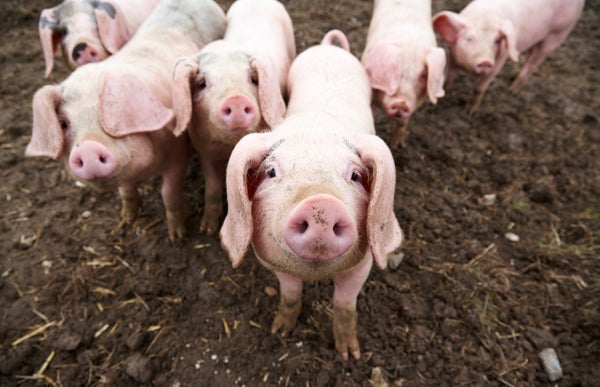Scientists have discovered a dangerous and highly transmissible form of multidrug-resistant bacteria lurking on a Midwestern hog farm, according to a study published yesterday. The bacteria have easily shared bits of DNA that help them fight off antibiotics called carbapenems, and this is the first time such microbes have been found on a U.S. farm. When these bacteria infect humans, they are extremely difficult to treat, and are often deadly. The discovery also poses something of a mystery. Carbapenems are not used on farms—they are mostly used in hospitals—so it is perplexing that microbes developed abilities to withstand a drug they probably did not encounter.
The feat illustrates the ease with which antibiotic resistance traits travel to new locations and jump into different species, but it is still unclear what the findings mean for public health. As yet there is “no evidence that it is entering the food supply,” says Thomas Wittum, a scientist at The Ohio State University College of Veterinary Medicine who published the findings in Antimicrobial Agents and Chemotherapy along with his colleagues. “It is a rare resistant strain on a single farm,” he adds. “We will need to do a lot more research before we can say what exactly the risk is.”
The researchers collected samples over the course of four visits to a farm that raises 1,500 hogs a year. They swabbed surfaces that come into contact with both animals and farm employees: crate bars, pen gates, floor mats, doorknobs and feed scoops, among other things. They also collected some hog rectal swabs and fecal samples.
On supporting science journalism
If you're enjoying this article, consider supporting our award-winning journalism by subscribing. By purchasing a subscription you are helping to ensure the future of impactful stories about the discoveries and ideas shaping our world today.
Wittum and his colleagues found that 18 samples, collected from surfaces that housed piglets and sows, harbored bacteria called carbapenem-resistant Enterobacteriaceae (CRE). The gene that helped them withstand the antibiotic was on a circular piece of DNA called a plasmid, and this particular circle is notorious for its ability to share copies of itself with other bacterial species in the presence of other “helper” plasmids. Indeed, “the striking evidence from this study is that they found [the resistance gene] in multiple species of bacteria, and that strongly suggests that it has moved around,” says Tim Johnson, a microbiologist at the University of Minnesota College of Veterinary Medicine. A study published in January 2016 found carbapenem-resistant bacteria in dairy cow manure on farms in New Mexico and Texas—yet these resistance genes were not on plasmids, but rather on bacterial chromosomes, which are not shared in the same way.
No one is sure where these resistance genes came from or how they got to the farm but researchers have ideas. “The most logical source would be a hospital, where carbapenems are frequently used and CRE are not uncommon,” Wittum says. Farm workers might, for instance, carry CRE home from a hospital visit and then deposit the bacteria on farm equipment.
But even if some bacteria were left on a doorknob by a farm employee, why did the microbes with the resistance trait stick around in animals? Resistance typically does not persist if it is not useful—and it is difficult to see the advantage of carrying a shield against an antibiotic that is not used in agriculture. One possibility is that a different antibiotic used on pigs, called ceftiofur, might be to blame. Ceftiofur molecules are structurally similar to carbapenems, and because of that genes that confer resistance to one frequently provide resistance to the other. This scenario is supported by the fact that researchers did not find CRE in samples collected from barns housing older hogs; ceftiofur is only used in young animals, and the resistance may dissipate as the hogs get older.
Studies have shown that bacteria passed from people to animals can then evolve in ways to make them more dangerous. In a 2012 study published in Mbio, researchers reported that a strain of methicillin-resistant Staphylococcus aureus (MRSA) in Europe acquired its methicillin resistance as well as resistance to another drug, tetracycline, after jumping from people into pigs on farms. Then it jumped back into people again, causing serious illness. One cannot help but worry, says Keeve Nachman, director of the Food Production and Public Health Program at the Johns Hopkins Center for a Livable Future, that additional harmful genes will get off the farm in the future.
